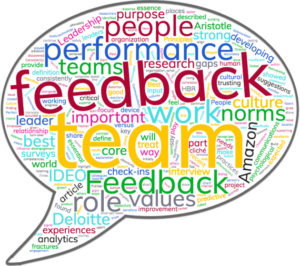Are you familiar with the “sandwich technique” for giving feedback? It goes like this: start with a positive; share a negative; end with a positive. It can be effective, if used correctly. Unfortunately, too many conflict-avoidant leaders use it to soft-pedal a crucial conversation that needs to be clearly communicated.
There are three main reasons leaders avoid having a direct conversation: they don’t know how to start; they don’t have specific examples; they don’t know how to end it. The C.O.R.E. Feedback Formula is your guide to giving conflict-feed feedback that results in changed behavior, without making anyone feel bad.
The four components of the C.O.R.E. formula are:
Conversation Starter
How you start will make or break the conversation. If you get started on the wrong foot you might as well end it right then and there and start over later. Because you asking them to change a behavior or improve their performance, it’s critical that you get buy-in. The whole key to a successful coaching session is to make it a two-way conversation. That means asking a lot of questions that encourages the employee to participate in the discussion.
You’ll have to choose the best conversation starter based on the dynamics of your specific situation but are here is one proven, time-tested phrase:
“I have a problem and I need your help.” It’s true. If an employee isn’t doing what they are supposed to do, you have a problem. And, you do need their help to fix it. In fact, they are the only one who can fix it. This approach ensures a collaborative approach from the start.
Observed Behavior or Performance
It’s important to take the time to get the concrete, observable facts before sitting down with the employee. It has to be a firsthand account, not a report from a third-party. You may have heard about the issue from their co-worker but you have to see the problem for yourself. If you don’t, the employee will get defensive and think that everyone is talking about them and that won’t help the situation.
This means you have to walk around and see what’s going on or gather data through reports. Either way, you need the facts in front of you so you don’t get sucked into what I call the Drama Vortex. That’s when the employee starts making excuses or deflects responsibility. When you have the facts, you’ll have the confidence to keep the conversation going in the right direction.
Required Behavior or Performance
Hopefully you have clearly defined and communicated both the behavior and performance expectations of the job. If you haven’t, it is nearly impossible to provide effective feedback so you will want to make establishing performance expectations a priority. It’s easy to assume that people know how much work they need to do; how accurate it needs to be; and how quickly it needs to be done. But, according to a Gallup study only 50% of employees know what is expected of them on a daily basis. It’s a good idea to make sure that you have made the expectations clear ahead of time.
If you have, then this is the time to remind them of where they need to be. Again, stick to the facts.
End the Conversation
This isn’t the time to trail off and hope that they will do what you want them to do. This is the time for clear agreement. The main goal of the coaching conversation is to get agreement that they will take action to improve.
You also want to make it clear that you want them to succeed and that you are willing to support them and provide any necessary resources. You might say something like, “Is there anything that will prevent you from completing your work within the stated timeframe.”
When done right, the employee will leave the coaching conversation with a clear understanding of what needs to improve and they will know you that are there to help them succeed. They will also respect you more for being direct and clear with them instead of relying on the old sandwich technique.
